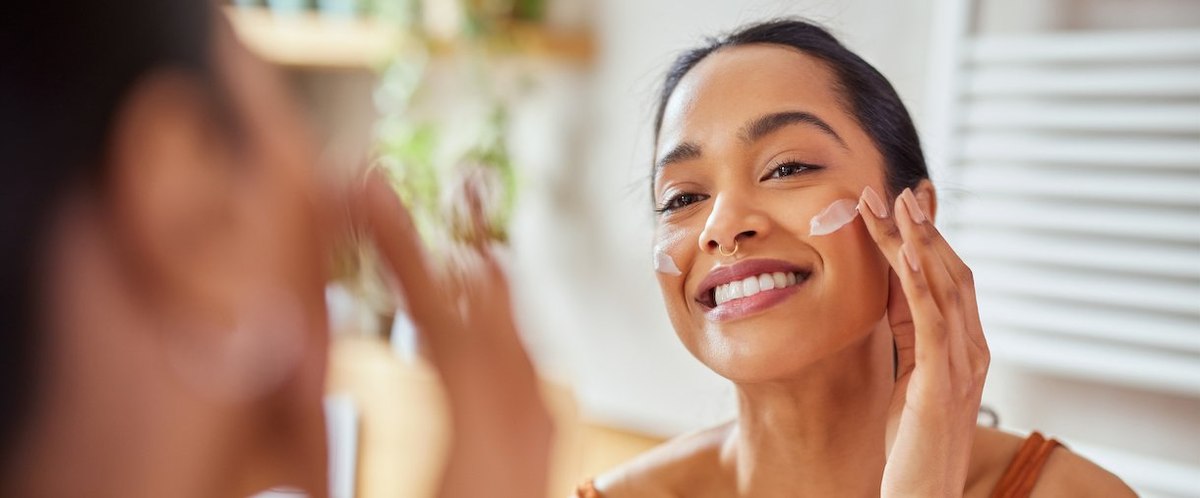A new YouGov survey asked Americans about their skin-care routines, the products they’re using, and how much they’re willing to spend on skin care. Women are more likely than men to have a consistent skin-care routine, to use a wide variety of products at least daily, and to be willing to spend more on products.
50% of Americans say they have a very or somewhat consistent skin-care routine, including 20% who say their routine is very consistent. Women (60%) are more likely than men (39%) to say they have a consistent skin-care routine. 18% of women and 36% of men do not have a skin-care routine at all.
What’s included in a skin-care routine? The most-used item is lip balm, with 35% of women and 10% of men saying they use this product multiple times per day. Cleanser is another commonly used item: 7% of men use it multiple times a day and 10% use it once a day. Among women, 19% use cleanser multiple times a day and 24% use it once a day. 17% of men and 46% of women use moisturizer at least once a day.
Additionally, 26% of women and 10% of men have used pore strips; 25% of women and 6% of men have used retinol. Fewer have used facial rollers (18% of women and 5% of men), dermaplaning (11% of women and 2% of men), or LED light therapy (8% of women and 6% of men) as skin-care treatments.
The cost of skin care can vary greatly. 15% of Americans say the maximum amount they would spend on a single skin-care product is $10 or less; 19% say the maximum amount they would spend on one product is between $11 to $20. 15% say their maximum is between $21 and $30; 9% say their maximum is between $31 and $40; and 16% say their maximum is $41 or more. Women are willing to spend more than men: 9% of women say they'd spend more than $60 on a product, compared to just 2% of men.
When buying skin-care products, the most important factor cited among five asked about is affordability: 72% say this is very or somewhat important. 66% say whether it has positive reviews online is a very or somewhat important factor and 60% say whether it is dermatologist-recommended is important.
Women are more likely than men to have a consistent skin-care routine, but that doesn’t mean they are more likely to be satisfied than men are with their skin’s appearance. Women (69%) and men (70%) are equally likely to be very or somewhat satisfied with their skin.
Among people who have a very or somewhat consistent skin care routine, 75% are satisfied with their skin. Among people who do not have a consistent skin-care routine or don’t have one at all, 63% are satisfied with their skin.
Women are more likely than men to be concerned about most skin conditions asked about in the survey. 46% of women and 18% of men name wrinkles as a skin concern; women are also more likely to have concerns about acne (26% vs. 20%), sensitivity (23% vs. 11%), redness (22% vs 10%), and enlarged pores (21% vs. 10%).
People of different ages also have differing skin concerns. Among adults under 30, 60% are concerned about acne; only 13% of adults 30 and older have this concern. Americans 65 and older are especially likely to name wrinkles (47%) as a skin concern while just 29% of younger adults say the same.
— Taylor Orth and Carl Bialik contributed to this article
Related:
- How often — and why — American women wear makeup
- Most Americans believe the media promotes an unattainable body image for women
- Americans with higher incomes are more likely to have straight, white teeth
See the results for this YouGov poll.
Methodology: The YouGov poll was conducted online on April 11 - 15, 2024 among 1,148 U.S. adult citizens. Respondents were selected from YouGov’s opt-in panel using sample matching. A random sample (stratified by gender, age, race, education, geographic region, and voter registration) was selected from the 2019 American Community Survey. The sample was weighted according to gender, age, race, education, 2020 election turnout and presidential vote, baseline party identification, and current voter registration status. Demographic weighting targets come from the 2019 American Community Survey. Baseline party identification is the respondent’s most recent answer given prior to November 1, 2022, and is weighted to the estimated distribution at that time (33% Democratic, 31% Republican). The margin of error for the overall sample is approximately 4%.
Image: Getty









